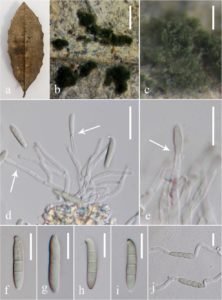Fusariella curvata C.G. Lin, Yong Wang bis & K.D. Hyde, sp. nov.; Index Fungorum number: IF552354
Etymology: In reference to the tip of each conidium being curved laterally
Holotype: MFLU 15-3268
Asexual morph: Colonies on natural substrate effuse, greyish green. Mycelium partly superficial and partly immersed. Conidiophores macronematous, mononematous, erect, branched, straight or flexuous, smooth, 1–3-septate, hyaline, up to 70 μm long, up to 4.5 μm wide. Conidiogenous cells monophialidic, integrated, terminal or laterally intercalary, straight or flexuous, subulate, smooth, hyaline, 19.5–31.5 μm (x = 23.9 μm, n = 20) long, 2.0–3.0 μm (x = 2.4 μm, n = 20) wide at the base, tapering slightly to the apex to 1.0–2.0 μm (x = 1.6 μm, n = 20) wide. Conidia catenate, acrogenous, usually straight but sometimes curved, fusiform, obclavate, rounded at the base and pointed at the apex, mostly the apical cell of each conidium curved laterally, 1–3-septate (mostly 3-septate), slightly constricted at the septa, smooth, hyaline when young, pale olivaceous when mature, 18–24 μm (x = 20.5 μm, n = 50) long, 3.0–4.5 μm (x = 3.8 μm, n = 50) wide at the widest point. Sexual morph: Undetermined.
Culture characteristics: Conidia germinating on PDAwithin 24 h. Colonies on MEA effuse, in concentric rings with radial wrinkles in the centre, white from above, light yellow from below, reaching a diam. of 2–3 cm in 20 days at 25 °C.
Material examined: THAILAND, Chiang Rai, Mae Sai District, Ang Kep Nam Wat Tham Khao Hin Phayanak (Wat Tham Sao Hin Payanak), 20°19′16.58 – 30.12″N, 99°51′40.72 – 54.50″E, on decaying Quercus sp. leaf, 19 June 2015, C.-G. Lin, WTSP 10-1 (MFLU 15-3268, holotype; HGUP 8001, isotype), living culture MFLUCC 15-0844 = GUCC 8001.
Notes: The shape of conidium (tip mostly curved laterally) clearly distinguishes this species from all other Fusariella
species. Conidia of our new species are similar to those of F. sinensis H.M. Liu & T.Y. Zhang, but the conidiogenous cells of our new species are smooth and hyaline, while those of F. sinensis are distinctly verrucose and coloured. Additionally, conidia of our new species are longer but narrower than those of F. sinensis (10–15 × 4.4–5.5 μm, x = 13.5 × 5 μm) (Liu and Zhang 2006). Fusariella concinna (Syd.) S. Hughes is similar to our new species in conidial shape, sometimes the conidia of F. concinna are slightly curved or bent above. However, conidia of F. concinna mostly are curved, fusoid but tapering towards the apex, whereas those of our new species are straight, fusiform, obclavate. Additionally, conidia of F. concinna are hyaline to slightly coloured with a well-defined basal scar, while those of our new species are hyaline when young, pale olivaceous when mature.
Fig. Fusariella curvata (holotype MFLU 15-3268). a Host leaf. b, c Conidiophores on the host surface. d, e Conidiophores, conidiogenous cells and conidia. f–i Conidia. j Germinating conidia. Scale bars: b = 1000 μm, c = 200 μm, d = 20 μm, e–j = 10 μm.

